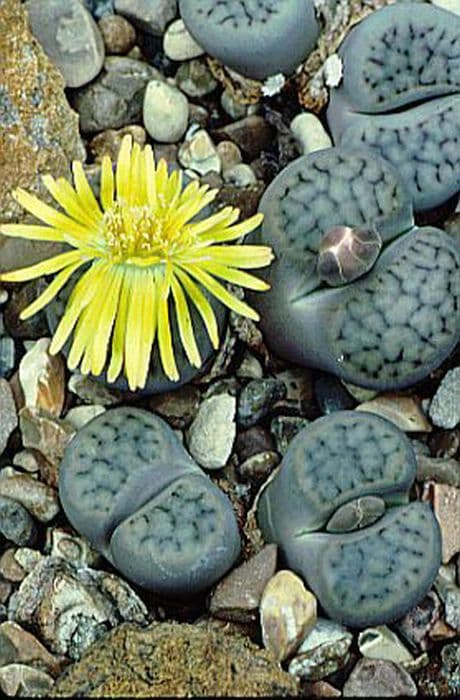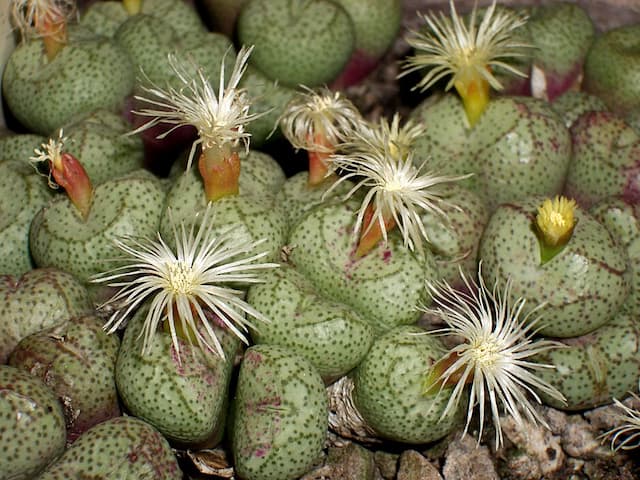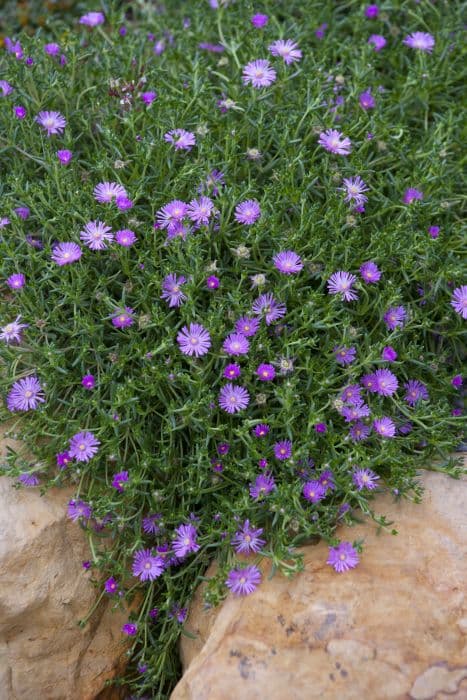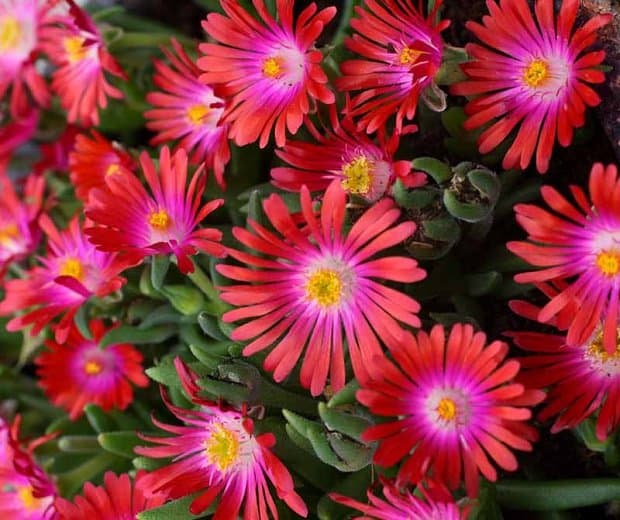Living stones Lithops schwantesii

ABOUT
Lithops schwantesii, commonly known as living stones, are intriguing succulents that mimic the appearance of stones or pebbles. This adaptation is a survival strategy to blend into their natural rocky environment, making them less visible to foraging animals. Each plant is comprised of two thick, fleshy leaves that are fused together. The top surface of the leaves often features intricate patterns and may come in a variety of colors like green, gray, brown, or even a rusty orange, with mottled spots or patches that enhance their stone-like appearance. The cleft between the leaves is deep and from this fissure, during the flowering season, emerges a daisy-like flower, often vibrant yellow or sometimes white, which contrasts strikingly with the muted tones of the leaves. After flowering, the living stone plant may produce new leaf pairs, with the old leaves gradually withering away. The surface of the leaves may also be slightly translucent, allowing sunlight to penetrate for photosynthesis, a feature that adds to their peculiar yet captivating look.
About this plant
 Names
NamesFamily
Aizoaceae
Synonyms
Living Stones, Pebble Plants, Flowering Stones, Mesembs, Mimicry Plants
Common names
Lithops schwantesii var. urikosensis, Lithops urikosensis
 Toxicity
ToxicityTo humans
Lithops schwantesii, commonly known as living stones, is generally considered non-toxic to humans. There is no significant evidence to suggest that ingesting small quantities of this plant would lead to poisoning or adverse health effects. However, it is always advisable not to consume any plant parts unless they are known to be edible, as individual sensitivities or allergic reactions could potentially occur.
To pets
Living stones are not known to be toxic to pets. There have been no significant reports of illness or poisoning in pets such as cats and dogs after ingesting the plant. Nevertheless, keeping an eye on pets and preventing them from eating ornamental plants is sensible, as ingestion can sometimes lead to gastrointestinal upset due to the unusual nature of the material rather than chemical toxicity.
 Characteristics
CharacteristicsLife cycle
Perennials
Foliage type
Evergreen
Color of leaves
Varies
Flower color
White
Height
1 inch (2.5 cm)
Spread
1 inch (2.5 cm)
Plant type
Succulent
Hardiness zones
10
Native area
Namibia
Benefits
 General Benefits
General Benefits- Low Maintenance: Lithops schwantesii, commonly known as Living Stones, requires minimal care which is perfect for busy plant owners.
- Drought-Tolerant: As a succulent, it can survive long periods without water, making it ideal for arid climates or forgetful waterers.
- Unique Aesthetic: With its stone-like appearance, it adds a unique visual interest to any plant collection or succulent garden.
- Small Size: Its compact size makes it suitable for small spaces such as apartments or desktops.
- Educational: Living Stones serve as a great educational tool to teach about camouflage and adaptation in plants.
- Long-Lived: These plants can live for several decades with proper care, making them a long-term companion.
 Medical Properties
Medical PropertiesThis plant is not used for medical purposes.
 Air-purifying Qualities
Air-purifying QualitiesThis plant is not specifically known for air purifying qualities.
 Other Uses
Other Uses- Lithops schwantesii, commonly known as Living Stones, can be used in miniature gardens as they mimic small stone formations and blend with other succulent varieties for a rocky landscape scene.
- In education, Living Stones can serve as a tool to teach children about mimicry and adaptation, illustrating how plants can evolve to resemble their surroundings for survival.
- As a collectible, enthusiasts of succulents treasure Living Stones for their unusual appearance and enjoy the challenge of cultivating and breeding different varieties.
- Photography enthusiasts often use Living Stones as subjects for macro photography, showcasing their textures and colors in close-up images.
- Living Stones can be used as a natural art medium in which the plants themselves can be arranged to create living sculptures due to their unique shapes.
- In water-wise landscaping, Living Stones are an excellent choice for xeriscaping, contributing to sustainable gardens that require minimal water.
- Lithops schwantesii can play a role in preventing soil erosion in small pots or terrariums due to their compact root systems that help to hold the soil together.
- They can be utilized in stress-relief or mindfulness practices, as their care requires patience and observance, which can be meditative for some hobbyists.
- For tabletop gaming and miniature setting enthusiasts, Living Stones can be incorporated into dioramas to add a realistic and exotic touch to the landscapes.
- As a conversation starter, these plants can intrigue guests due to their rock-like appearance, often sparking discussions about botany and plant adaptations.
Interesting Facts
 Feng Shui
Feng ShuiThe Living Stones are not used in Feng Shui practice.
 Zodiac Sign Compitability
Zodiac Sign CompitabilityThe Living Stones are not used in astrology practice.
 Plant Symbolism
Plant Symbolism- Resilience: Known as "living stones," Lithops schwantesii is highly resilient and can survive harsh conditions, signifying the ability to endure and adapt to life's challenges.
- Patience: These plants take a slow pace to grow, symbolizing patience and the understanding that some things in life cannot be rushed.
- Conservation: Lithops schwantesii require minimal water, representing conservation of resources and eco-friendliness.
- Self-sufficiency: Given their low maintenance, these plants symbolize independence and the ability to thrive with very little.
 Water
WaterThe Living Stones, or Lithops schwantesii, should be watered sparingly as they are susceptible to overwatering. During the spring and summer, water them every two to three weeks with about 2 to 3 ounces of water per plant, allowing the soil to dry out completely between waterings. In the fall, reduce watering to once a month until winter when you should stop watering altogether to mimic their natural dormancy period. Resume watering lightly in spring when you see new growth.
 Light
LightLiving Stones thrive in bright, indirect sunlight. A south-facing window that provides plenty of light without direct sun exposure is ideal. They can tolerate direct sunlight in the early morning or late afternoon but should be protected from the harsh midday sun to prevent scorching their leaves.
 Temperature
TemperatureLiving Stones prefer warm temperatures between 65 and 80 degrees Fahrenheit. They can tolerate temperatures as low as 40 degrees Fahrenheit, but should not be subjected to frost, as it can be detrimental. Maintaining an environment within this temperature range will encourage healthy growth for Lithops schwantesii.
 Pruning
PruningLiving Stones rarely require pruning due to their slow growth habit. However, if old leaves do not shrivel and are not easily removed by hand, they can be gently pruned away. Pruning should be done after the new leaf pair has fully developed, which usually occurs in late summer to fall.
 Cleaning
CleaningAs needed
 Soil
SoilThe best soil mix for Living Stones (Lithops schwantesii) is a well-draining mix with coarse sand, fine gravel, and peat or a cactus mix to mimic its natural habitat. A mixture of half potting soil and half sand with small gravel or perlite is ideal. The preferred soil pH for Living Stones is slightly acidic to neutral, around 5.5 to 7.2.
 Repotting
RepottingLiving Stones (Lithops schwantesii) should be repotted every few years or when they outgrow their container. It's best to repot during the late spring or early summer, which is the beginning of their active growth period. This should be done infrequently, typically once every 3 to 4 years, to minimize stress on the plants.
 Humidity & Misting
Humidity & MistingLiving Stones (Lithops schwantesii) prefer low to moderate humidity levels, as they are native to arid environments. Ideal humidity should range from 30% to 50%. Keeping them in a dry environment helps prevent issues such as rot and fungal infections.
 Suitable locations
Suitable locationsIndoor
Place Living Stones in bright, indirect light indoors.
Outdoor
Ensure full sun to light shade and protection from heavy rain outdoors.
Hardiness zone
10-11 USDA
 Life cycle
Life cycleLithops schwantesii, commonly known as Schwantes' living stone, begins its life cycle as a seed, which, when exposed to favorable conditions of moisture and temperature, germinates to produce a tiny, two-leafed seedling. These succulent leaves are designed to store water, enabling the plant to survive in arid environments. As the plant matures, it produces new pairs of leaves annually from a meristem situated between the older leaf-pairs, which eventually dry up and wither away. During its growth period, Schwantes' living stone remains mostly underground, with only the leaf tops being visible above the soil, camouflaging with the surrounding rocks. Upon reaching maturity, Lithops schwantesii blooms in the fall with daisy-like flowers, usually yellow or white, that emerge from between the leaf pairs. After pollination and seed set, the plant goes into a dormant period during the winter, conserving energy for the next growth cycle.
 Propogation
PropogationPropogation time
Spring to Summer
The most popular method to propagate Lithops schwantesii, commonly known as Living Stones, is by seed. The best time for sowing Lithops seeds is in the spring or early summer when temperatures are warm, which mirrors their native growing conditions. To propagate Living Stones by seed, start by filling a shallow tray with a well-draining soil mix suitable for cacti and succulents. Scatter the tiny seeds over the surface and lightly cover them with a fine layer of sand or the same soil mix. The tray should then be placed in a warm, bright area but out of direct sunlight, and the soil must be kept moist but not waterlogged. Germination can take from a couple of weeks to a month. Once the seedlings have developed a couple of true leaves and are large enough to handle, they can be gently transplanted into individual pots.









